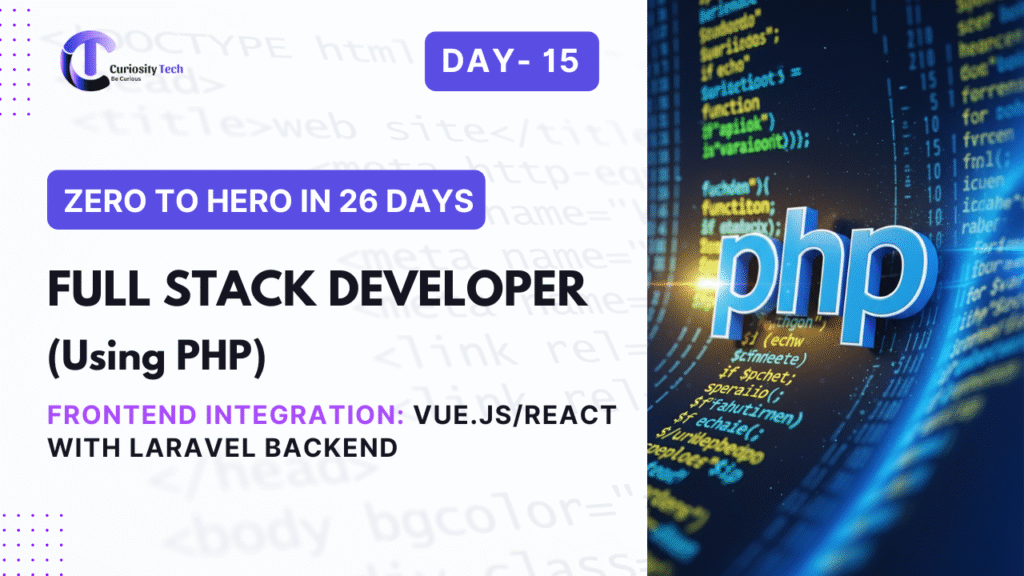Introduction
On Day 15, we explore integrating modern frontend frameworks (Vue.js or React) with a Laravel backend, a critical skill for Full Stack PHP Developers. This integration allows dynamic, responsive user interfaces that interact seamlessly with backend APIs.
At CuriosityTech.in, learners gain hands-on experience connecting Laravel APIs (Day 13) with Vue.js or React components, creating interactive dashboards, online stores, and SPAs (Single Page Applications).
1. Why Integrate Frontend Frameworks with Laravel?

2. Setting Up Vue.js in Laravel
Laravel comes pre-configured with Vite for frontend tooling.
Step 1: Install Vue.js
npm install vue@next
npm install
npm run dev
Step 2: Create a Vue Component
File: resources/js/Components/CourseList.vue
<template>
<div>
<h2>Available Courses</h2>
<ul>
<li v-for=”course in courses” :key=”course.id”>
{{ course.name }} – {{ course.description }}
</li>
</ul>
</div>
</template>
<script>
export default {
props: [‘courses’]
}
</script>
Step 3: Mount Vue Component
File: resources/js/app.js
import { createApp } from ‘vue’;
import CourseList from ‘./Components/CourseList.vue’;
const app = createApp({});
app.component(‘course-list’, CourseList);
app.mount(‘#app’);
Step 4: Use in Blade Template
<div id=”app”>
<course-list :courses=’@json($courses)’></course-list>
</div>
<script type=”module” src=”{{ mix(‘js/app.js’) }}”></script>
3. Setting Up React in Laravel
Step 1: Install React
npm install react react-dom
npm install
npm run dev
Step 2: Create React Component
File: resources/js/components/CourseList.jsx
import React from ‘react’;
export default function CourseList({ courses }) {
return (
<div>
<h2>Available Courses</h2>
<ul>
{courses.map(course => (
<li key={course.id}>
{course.name} – {course.description}
</li>
))}
</ul>
</div>
);
}
Step 3: Mount React Component
File: resources/js/app.js
import React from ‘react’;
import { createRoot } from ‘react-dom/client’;
import CourseList from ‘./components/CourseList.jsx’;
const container = document.getElementById(‘app’);
const root = createRoot(container);
const courses = JSON.parse(container.dataset.courses);
root.render(<CourseList courses={courses} />);
Step 4: Use in Blade Template
<div id=”app” data-courses=’@json($courses)’></div>
<script type=”module” src=”{{ mix(‘js/app.js’) }}”></script>
4. Fetching Data from Laravel API
Instead of passing data directly from Blade, you can fetch data from Laravel REST API:
fetch(‘/api/courses’)
.then(res => res.json())
.then(data => {
// Use data in Vue or React component
});
This approach allows decoupling frontend from backend, ideal for SPAs and mobile apps.
5. Hierarchical Diagram: Frontend-Backend Integration

6. CuriosityTech.in Perspective
At CuriosityTech.in, learners combine Laravel backend with Vue.js or React frontends to create interactive dashboards, dynamic forms, and real-time data apps. By mastering this integration, students become full-stack developers capable of building modern, production-ready applications.
Projects include e-commerce stores, course management platforms, and live dashboards, ensuring learners understand both backend APIs and frontend rendering.
7. Infographic Concept: Frontend-Backend Flow

Conclusion
Integrating Vue.js or React with Laravel equips Full Stack Developers to build modern, interactive, and reactive web applications. Today’s skills bridge the gap between backend APIs and dynamic frontend UIs, paving the way for advanced media handling (Day 16) and professional-level full-stack projects.



